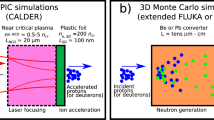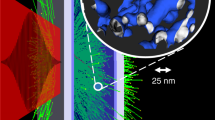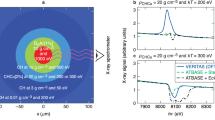Abstract
As a form of matter intermediate between molecules and bulk solids, atomic clusters have been much studied1. Light-induced processes in clusters can lead to photo-fragmentation2,3 and Coulombic fission4, producing atom and ion fragments with a few electronvolts (eV) of energy. However, recent studies of thephotoionization of atomic clusters with high intensity (>1016 W cm−2) femtosecond laser pulses have shown that these interactions can be far more energetic5,6,7,8,9,10,11,12,13—excitation of large atomic clusters can produce a superheated microplasma that ejects ions with kinetic energies up to 1 MeV (ref. 10). This phenomenon suggests that through irradiation of deuterium clusters, it would be possible to create plasmas with sufficient average ion energy for substantial nuclear fusion. Here we report the observation of nuclear fusion from the explosions of deuterium clusters heated with a compact, high-repetition-rate table-top laser. We achieve an efficiency of about 105 fusion neutrons per joule of incident laser energy, which approaches the efficiency of large-scale laser-driven fusion experiments. Our results should facilitate a range of fusion experiments using small-scale lasers, and may ultimately lead to the development of a table-top neutron source, which could potentially find wide application in materials studies.
This is a preview of subscription content, access via your institution
Access options
Subscribe to this journal
Receive 51 print issues and online access
$199.00 per year
only $3.90 per issue
Buy this article
- Purchase on Springer Link
- Instant access to full article PDF
Prices may be subject to local taxes which are calculated during checkout



Similar content being viewed by others
References
Castleman, A. W. & Keesee, R. G. Gas-phase clusters: spanning the states of matter. Science 241, 36–42 (1988).
Desai, S., Feigerle, C. S. & Miller, J. C. Multiphoton ionization and photodissociation of (NO)mArnclusters. Z. Phys. D 26, 220–222 (1993).
Ernstberger, B., Krause, H., Kiermeier, A. & Neusser, H. J. Multiphoton ionization and dissociation of mixed van der Waals clusters in a linear reflectron time-of-flight spectrometer. J. Chem. Phys. 92, 5285–5296 (1990).
Gotts, N. G., Lethbridge, P. G. & Stace, A. J. Observation of Coulomb explosion in doubly charged atomic and molecular clusters. J. Chem. Phys. 96, 408–421 (1992).
McPherson, A., Thompson, B. D., Borisov, A. B., Boyer, K. & Rhodes, C. K. Multiphoton-induced X-ray emission at 4–5 keV from Xe atoms with multiple core vacancies. Nature 370, 631–634 (1994).
Purnell, J., Snyder, E. M., Wei, S. & Castlemand, A. W. Ultrafast laser-induced Coulomb explosion of clusters with high charge states. Chem. Phys. Lett. 229, 333–339 (1994).
Ditmire, T., Donnelly, T., Falcone, R. W. & Perry, M. D. Strong X-ray emission from high-temperature plasmas produced by intense irradiation of clusters. Phys. Rev. Lett. 75, 3122–3125 (1995).
Shao, Y. L. et al. Multi-keV electron generation in the interaction of intense laser pulses with Xe clusters. Phys. Rev. Lett. 77, 3343–3346 (1996).
Snyder, E. M., Buzza, S. A. & Castleman, A. W. Intense field-matter interactions: multiple ionization of clusters. Phys. Rev. Lett. 77, 3347–3350 (1996).
Ditmire, T. et al. High-energy ions produced in explosions of superheated atomic clusters. Nature 386, 54–56 (1997).
Lezius, M., Dobosz, S., Normand, D. & Schmidt, M. Hot nanoplasmas from intense laser irradiation of argon clusters. J. Phys. B: At. Mol. Opt. Phys. 30, L251–L258 (1997).
Rose-Petruck, C., Schafer, K. J., Wilson, K. R. & Barty, C. P. J. Ultrafast electron dynamics and inner-shell ionization in laser driven clusters. Phys. Rev. A 55, 1182–1190 (1997).
Lezius, M., Dobosz, S., Normand, D. & Schmidt, M. Explosion dynamics of rare gas clusters in strong laser fields. Phys. Rev. Lett. 80, 261–264 (1998).
Dittrich, T. R. et al. Diagnosis of pusher-fuel mix in indirectly driven nova implosions. Phys. Rev. Lett. 73, 2324–2327 (1994).
Daido, H. et al. Neutron-production from a shell-confined carbon–deuterium plasma by 1.06-µm laser irradiation. Appl. Phys. Lett. 51, 2195–2196 (1987).
Obst, A. W., Chrien, R. E. & Wilke, M. D. Colliding plasma neutron production at Trident. Rev. Sci. Instrum. 68, 618–620 (1997).
Key, M. H. et al. Hot electron production and heating by hot electrons in fast ignitor research. Phys. Plas. 5, 1966–1972 (1998)
Pretzler, G. et al. Neutron production by 200 mJ ultrashort laser pulses. Phys. Rev. E. 58, 1165–1168 (1998).
Ditmire, T., Donnelly6, T., Rubenchik, A. M., Falcone, R. W. & Perry, M. D. The interaction of intense laser pulses with atomic clusters. Phys. Rev. A 53, 3379–3402 (1996).
Ditmire, T. et al. High energy explosion of super-heated clusters: Transition from molecular to plasma behavior. Phys. Rev. Lett. 78, 2732–2735 (1997).
Strickland, D. & Mourou, G. Compression of amplified chirped optical pulses. Opt. Comm. 56, 219–221 (1985).
Smith, R. A., Ditmire, T. & Tisch, J. W. G. Characterization of a cryogenically cooled high-pressure gas jet for laser/cluster interaction experiments. Rev. Sci. Instrum. 69, 3798–3804 (1998).
Klingelhöfer, R. & Moser, H. O. Production of large hydrogen clusters in condensed molecular beams. J. Appl. Phys. 43, 4575–4579 (1972).
Ditmire, T., Smith, R. A., Tisch, J. W. G. & Hutchinson, M. H. R. Absorption of high intensity laser pulses in gases of clusters. Phys. Rev. Lett. 78, 3121–3124 (1997).
Shigemori, K. et al. Measurement of strong blast waves in gas cluster targets. Ap. J. Lett. (submitted).
Teller, E. Fusion(Academic, New York, (1981).
Zweiback, J., Ditmire, T. & Perry, M. D. Femtosecond time resolved studies of the dynamics of noble gas cluster explosions. Phys. Rev. Lett. A (in the press).
Loveman, R., Bendahan, J., Gozani, T. & Stevenson, J. Time-of-flight fast-neutron radiography. Nucl. Instrum. Meth. Phys. Res. B: Beam Interact. Mater. Atoms 99, 765–768 (1995).
Acknowledgements
We thank R. Smith, J. Tisch and other collaborators from Imperial College for many useful conversations; M. Perry and H. Powell for useful input; and V. Tsai for technical assistance.
Author information
Authors and Affiliations
Corresponding author
Rights and permissions
About this article
Cite this article
Ditmire, T., Zweiback, J., Yanovsky, V. et al. Nuclear fusion from explosions of femtosecond laser-heated deuterium clusters. Nature 398, 489–492 (1999). https://doi.org/10.1038/19037
Received:
Accepted:
Issue Date:
DOI: https://doi.org/10.1038/19037
This article is cited by
-
Characterization of the Spatial Atomic Density Distribution in Gas Jets from Three Different Nozzles
Russian Physics Journal (2024)
-
Spatial mapping of low pressure cluster jets using Rayleigh scattering
Scientific Reports (2023)
-
A squarate-pillared titanium oxide quantum sieve towards practical hydrogen isotope separation
Nature Communications (2023)
-
Low divergent MeV-class proton beam with micrometer source size driven by a few-cycle laser pulse
Scientific Reports (2022)
-
Review of laser-plasma physics research and applications in Korea
Journal of the Korean Physical Society (2022)
Comments
By submitting a comment you agree to abide by our Terms and Community Guidelines. If you find something abusive or that does not comply with our terms or guidelines please flag it as inappropriate.



